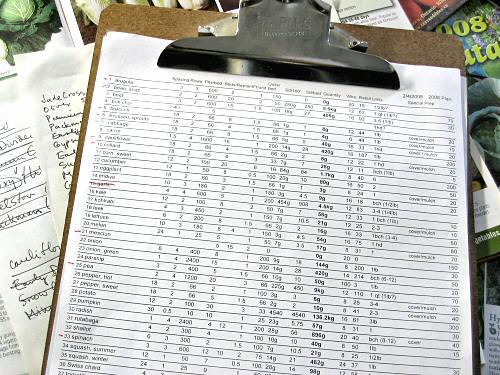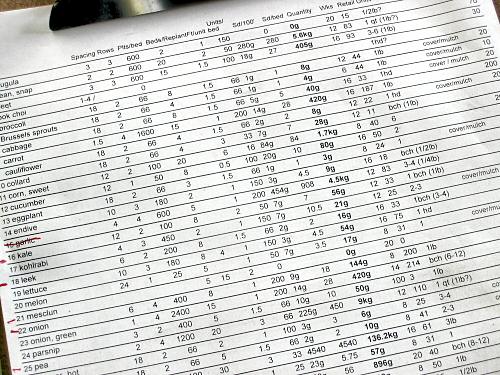
The first main seed order is finally done. There will be one more in a week or two, and then I’ll be set for the season. Working out the order was relatively painless, it does get easier every year, but without this handy Seed Quantity Calculator, my head would still be spinning. There are at least 65 different veggies, herbs, and flowers, and must be well over 200 varieties overall (wow, hard to believe when you add ’em up). It’s a lot to piece together.
Of course, I could REDUCE. That’s a whole other story (and then there’s the hybrids/seed-saving issue), but basically, I think variety is a great thing on all levels, so instead of reducing, I resist the urge to add more. For mainstay crops like green snap beans, I’ll try at least 2 or 3 similar varieties to see how they perform in this particular field (depending on conditions, the differences can be quite big). And you’ve gotta Try New Things, grow a little okra, some Jerusalem artichoke, LOVAGE, a row of tomatillos, and…lots more—even if a crop’s not exactly popular (self included), we can all learn! Crops, cultivars, there’s a lot of seed to choose from… And it gets more complicated.
On this tiny farm, where plantings are measured in multiples of 50 row feet, not in acres, the catalog price breaks are a maze of temptations and false economies. Seed for many crops becomes tantalizingly less expensive right after the first “bulk” quantity. For example, if 5g of something is $6, and 25g is $18, how can you pass up savings like that, especially when the difference is “only” 12 bucks? Freeze the extra and it’ll be good for years! But those extra 10 and 20 dollars add up real quick, and there are always lots more varieties to try.
So it goes, crop by crop, variety by variety, at ordering time. It could get real messy if I hadn’t long ago (Year 1!) worked out my seed quantity order sheet, which at least allows me to instantly check on how much space I really have, how much seed I really need, what the yield might be like… That helps!

The Sheet is pretty common sense. I set it up in a database, but it could as easily be a single spreadsheet. Some columns you enter the values, others are automatically calculated. I used to think of it as my master planning tool, where everything could eventually be worked out with pinpoint precision, but I got over that after a couple of years, and use it more loosely now. Here it is, column by column:
Spacing: in-row spacing, between plants (inches)
Rows: number of rows per bed, based on my 50’x5′ beds.
Plants per bed: automatically calculated (50′ × Rows per bed ÷ Plant spacing), a useful number when starting seedlings for transplants
Beds: how many beds of the crop do I want to plant out; this number is automatically totaled at the bottom of the sheet, and that clearly shouldn’t exceed my total of about 400 beds this year!
Replant: succession planting, how many times I expect to plant in a previously used bed
Feet per unit: how many row feet does it take for one sales unit, e.g. 1 unit of carrots is a 2 lb bunch; this is my own little innovation over the usual yield by weight, it makes more sense for weekly harvests, and it sorta works, but the numbers have to be…refined
Units per bed: automatically calculated (50′ × Rows per bed × Feet per unit)
Seed for 100′: quantity needed, starting with the standard seed catalog estimates, I adjusted most of ’em based on what I actually used, usually a function of the Earthway seeder’s particular (sometimes generous) seeding rate for individual crops
Seed per bed: automatically calculated (Rows per bed × 50 ÷ Seed for 100′)
Quantity: automatically calculated, this is the big total seed needed for the season number ((Beds + Replant) × Seed per bed)
Weeks: the harvest window, how many weeks the crop should be available over the season, including succession planting
Retail units: automatically calculated, how many units available each week, a crude but still kinda useful number that evenly divides the total expected production over the harvest weeks ((Beds + Replant) × Units per bed ÷ Weeks)
The rest is notes: what a sales unit is for a crop, like, one bunch or 2 lbs, etc, any special field prep (mulch, row cover) to quickly highlight the crops that’d take extra materials and work), and a seed cost note. The Beds + Replant and the cost are calculated in a grand total at the bottom of the sheet.
There you have it! It’s not rocket science, just a simple tool that actually works quite well. By changing a figure or two, you can instantly see how things will be affected overall. The last couple of years, I mostly use the sheet as a printout and plan with that and the field production map and a pencil, I don’t sit in front of the computer, tweaking numbers, ’cause by now what’s already entered is pretty much in the ballpark.
UPDATE! I added a Viability column, right after the crop name, for the number of years seed is good for in average storage conditions (these numbers vary A LOT for some crops, depending on your source, so find one you like. ;) This comes in handy when going over your inventory, if you have seed more than a couple of years old.




I LOVE this.. organization and planning get me so excited!!
My tiny plot is *much* smaller than your micro farm, but I’m still having fun reading through my first ever seed catalog (Baker Creek Heirloom Seeds)! I’ve narrowed my list to uh… 16 different things… way more than can grow in my tiny garden, so I guess I’ll have to reduce — I’m thinking I can realistically do 2 types of cucumbers, some tomatoes, purple tomatillos, and maybe some heirloom melons. Is there any reason not to mix fruits and vegetables? (I’m definitely an amateur at this…)
Guess what I’m going to be doing over the next few days :-D
As I’ve already input most of the seed varieties I’m growing for this year to give me a list of when to start planting what I’ve even got a head start.
Thanks for the forum link on seed starting under lights, I’ll be looking at setting that up over this summer ready for next year. The current electrics at the farm just wouldn’t take it this year. Turns out I have practically no sockets that are earthed and some of the wiring is a total bodge and as I only have 9W coming in (I don’t want to up the power load until the wiring is changed) I already trip out the system if I switch on too much Anyone else remember watching Greenacres?
I went ahead and picked out seeds for my first-ever garden plot without having done any calculations for how many I really need. But I’ve been wondering how big to build the beds now that I have the seeds. These formulas will be really helpful when I sit down and figure it all out. Thanks very much. :)
Love the blog!
Crumbs Mike – I think my brain’s melting. Glad you’re working it out and not me :)
I’m trying Okra for the first time this year too. The allotment forum I belong to has an Okra challenge this year, so I’m joining in. If any of us manage to get a crop this year, one of the other members will cook us all a meal. It’s a Canadian that’s set up the challenge for this year. It failed last year because of the bad summer…
Yeah, it felt good looking at the post after I wrote it out, because it really made me realize what a headache I’d have otherwise. Thank a nondenominational God for that sheet!!
hats off! for your organization skills – I truly admire.
Great idea with the chart. It has inspired me to design my own. Thanks for all the good information. Its nice to have a blazed trail for us newbies. Keep up the good work!
Wow, your whole site is filled with such useful information and wonderfully illustrative photos! I’m not at the “farming” stage yet – barely entering into the “not small garden” stage – but I’ve known for years I was headed towards something – and I think now, you have articulated for me part of what that something may turn out to be. My husband is NOT into gardening or farming or any of that sort of stuff, so I will have to be able to “be a one woman show and do it all.” Thanks for giving me a glimpse of possibilities and sharing your practical know how with the world!
KMom246: Sure, no problem! From casual observation here in garden blogland, and on this farm and at our farmers’ market, it does kinda seem that WOMEN are leading the way with tiny farming, CSA and local food…
Hi Mike,
I love the database that you’ve made. It’s been a huge help for me just to think in those sorts of terms. I was wondering if you would offer any/all of the results you have for the FEET PER UNIT column? I’ve never really payed attention to that sort of yield, but now as I’m expanding my garden into a micro-farm I would love any rough estimates you might have.
cheers,
steve
Steve C: The Feet Per Unit is by far the most garden-specific measurement on the sheet, my numbers really wouldn’t do you any good at all. For example, if I said I get a pound of carrots per row foot, that’d depend on size/maturity, thinning/final spacing, variety, and garden conditions. I could also pick some of the same planting as baby carrots, and then pull more later on as mature ones, and have a completely different yield and FPU. It’s very variable, you have to try it for yourself and see if this approach even makes sense for you… It’s probably easier to start estimating and measuring with yield by weight (yield per 50′ or 100′ is common in N. America, for example, check this chart). Hope that helps!
Mike,
I figured that would be the case. I guess what I am really looking for is something that might tell me an average yield of a single vegetable plant. I know that so much will vary between Zones and growing conditions, but I think I have been looking for something that doesn’t exist. Thanks anyways.
stephen.
Steve: No, that’s easy. For example, the chart I linked to above gives yield per 50′. For an approximate yield per plant, divide that figure by the spacing between plants. That’ll be an APPROXIMATE per plant yield… I’m not sure what you’re trying to do? If you want to plan smaller quantities, just divide from larger averages. Like, if 50′ yields so much, divide by 5 and that’s what 10′ delivers. How many plants is that? See the in-row spacing. If it’s 12″ spacing, then you need 10 plants for 10′. After you work from a plan for a season and take a couple of notes, you can adjust for what your garden actually produces.
It is difficult to imagine how you sow all those seeds but you will have the expert way .I did so poorly that am tempted to purchase a little seed dispenser from Lakeland stores for under £2which works a little like a needle dispenser ,allowing release of seeds possibly one at a time .it might save on seeds -well it might save on freezer space and electricity to freeze your catering size packs of seeds but then you probably already have automated methods of seed sowing -but it might do foryour kitchen garden